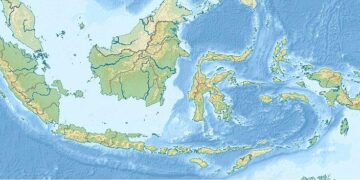As severe flooding continues to ravage Jakarta and its surrounding areas, Indonesian authorities have turned to an unconventional solution to mitigate the impact of relentless rains: cloud seeding. This weather modification technique aims to induce artificial rainfall, thereby dissipating excessive moisture in the atmosphere and potentially alleviating the deluge that has overwhelmed the capital city. With torrential downpours prompting widespread evacuations and disrupting daily life, the Indonesian government is employing cloud seeding in a bid to regain control over its unpredictable weather patterns. In this article, we explore the implications of this tactic, the science behind it, and the broader context of climate challenges facing the region.
Indonesia’s Cloud Seeding Efforts to Mitigate Flooding in Jakarta

Amid the ongoing struggles with flooding in Jakarta,the Indonesian government has turned to cloud seeding as a proactive measure to alleviate the impact of severe rainfalls. This technique involves dispersing substances into the atmosphere to encourage precipitation and modify weather patterns. By employing aircraft to release sodium chloride and other compounds, the authorities hope to manage the volume and intensity of rainfall, ultimately preventing severe flooding that disrupts daily life and endangers public safety. The strategy is notably crucial during the annual rainy season when Jakarta faces the heightened risk of inundation.
As part of this initiative, the government has outlined key components of their cloud seeding programme, including:
- Targeted Areas: Focusing on rain clouds over critical flood-prone regions.
- Timing: Conducting operations just before forecasts of heavy rain to maximize efficacy.
- Monitoring: Utilizing advanced meteorological equipment to track weather patterns and adjust efforts accordingly.
In a bid to enhance transparency and effectiveness, authorities have launched public information campaigns to educate citizens about the process and its potential benefits. This effort aims to foster understanding and build community support for innovative weather management practices while addressing immediate concerns about flooding in urban areas.
Understanding the Mechanisms of Cloud Seeding in Rain Management

The technique of cloud seeding operates on the principle of enhancing precipitation by introducing certain substances into the atmosphere. Commonly used materials include silver iodide, sodium chloride, and liquid ammonia, all of which serve as nuclei around which moisture droplets can form. These substances are typically dispersed from aircraft or ground-based generators into targeted cloud formations. Once these particles are introduced, they attract water vapor, leading to the growth of larger droplets that can eventually overcome air resistance and fall as rain. This method has been effectively employed in various countries, including Indonesia, to mitigate the effects of extreme weather conditions.
Key Factors Influencing Cloud Seeding:
- Cloud type: The effectiveness of cloud seeding largely depends on the type and structure of the clouds present.
- Humidity Levels: Sufficient moisture in the atmosphere is crucial for accomplished precipitation enhancement.
- Temperature: Cooler temperatures often facilitate the formation of ice crystals, aiding in the seeding process.
By utilizing cloud seeding, authorities can strategically manage weather patterns, especially during periods of heavy rainfall that may lead to severe flooding. In Jakarta,the implementation of this technology aims to direct rainfall away from vulnerable regions,reducing the risk of natural disasters and ensuring better protection for its residents.
| Aspect | Impact |
|---|---|
| Environmental Concern | Potential alteration of local ecosystems |
| Cost efficiency | Reduces the need for extensive drainage systems |
| Public Awareness | Informs citizens about weather management solutions |
The Impact of Heavy Rains and Flooding on Jakarta’s Infrastructure

The recent heavy rains and subsequent flooding in Jakarta have had a profound impact on the city’s already strained infrastructure. The incessant downpour has exacerbated existing vulnerabilities, leading to significant disruptions in transportation systems, supply chains, and public services. Key infrastructure components severely affected include:
- Roadways: Many main roads have become impassable, resulting in extended traffic delays and hindering emergency services.
- Public transport: Flooded train stations and bus routes have rendered many public transport systems unreliable, forcing commuters to seek alternative and often unsafe travel options.
- Utilities: Water and electricity supply disruptions have posed additional challenges, with residents facing interruptions in essential services during emergencies.
As authorities struggle to manage the fallout,the need for immediate and long-term solutions becomes increasingly evident. Solutions required to mitigate the impact of future floods may include:
- Investment in drainage systems: Enhancing the capacity of drainage infrastructure to better handle intense rainfall.
- Urban planning reforms: Implementing stricter zoning laws to prevent progress in flood-prone areas.
- Emergency response protocols: Establishing efficient emergency response practices to swiftly address affected communities during severe weather events.
evaluating the Effectiveness of Weather Modification Strategies

Cloud seeding has emerged as a pivotal tool in Indonesia’s arsenal against devastating floods, particularly in urban areas like Jakarta. This weather modification technique involves dispersing substances into the atmosphere to encourage and enhance precipitation in a controlled manner. Authorities aim to mitigate the severity of impending rainfalls, thereby reducing the risk of flooding. Evaluating the effectiveness of such strategies can be assessed through several key metrics:
- Reduction in Flood Incidence: Assessing the decrease in flood reports during periods of cloud seeding implementation.
- Rainfall Distribution: Analyzing the spatial and temporal distribution of rainfall before and after cloud seeding operations.
- Cost-Benefit Analysis: Weighing the financial costs of conducting cloud seeding against the potential savings from reduced flood damage.
The success of cloud seeding initiatives can also be influenced by environmental factors and technical execution. A thorough evaluation might include a comparison of expected versus actual precipitation measurements, with findings summarized in the following table:
| Month | Expected Rainfall (mm) | Actual Rainfall (mm) | Flood Incidence |
|---|---|---|---|
| January | 120 | 100 | 4 |
| February | 110 | 150 | 1 |
| March | 140 | 130 | 2 |
Such analyses not only provide insights into the immediate impacts of weather modification strategies but also guide future decisions on resource allocation and technical investments. Continuous monitoring and adaptation will play crucial roles in enhancing the resilience of cities like jakarta to extreme weather events.
Challenges and Controversies Surrounding Cloud Seeding Technologies

cloud seeding technologies, while touted as a solution for mitigating heavy rainfall and its associated flooding, are not without their share of challenges and controversies. Critics raise concerns regarding the environmental impact, questioning whether the introduction of artificial precipitation can disrupt local ecosystems. essential species may suffer from altered precipitation patterns, leading to a ripple effect that can impact agriculture, water supply, and biodiversity. Moreover, the ethical implications of manipulating weather patterns can create tension between neighboring regions, especially if weather modification leads to unintended consequences such as droughts in areas not targeted by seeding efforts.
Another challenge lies in the effectiveness and reliability of cloud seeding. While proponents argue that it can increase rainfall by up to 30% in some cases, results can vary significantly based on atmospheric conditions and the type of cloud formations present. This variability raises questions about the cost-effectiveness of these operations, as the financial investment in cloud seeding may not always yield the desired outcomes. Furthermore, as public policy grapples with the implications of technological interventions in natural processes, there is a pressing need for regulatory frameworks that ensure accountability and transparency in cloud seeding practices. Without clear guidelines, the potential for misuse or over-reliance on such technologies could undermine sustainable water management efforts.
| Challenges | Controversies |
|---|---|
| Environmental impact – Potential disruption to ecosystems | Ethical Concerns – Manipulating weather raises moral questions |
| Effectiveness - Variable results based on conditions | Cost-Effectiveness – High costs without guaranteed outcomes |
| Regulatory Needs – Lack of clear policies | Public Perception – Distrust among communities affected |
Recommendations for Sustainable Urban Water Management in Flood-Prone Areas

As urban areas continue to grapple with the challenges posed by excessive rainfall and flooding, implementing sustainable water management practices becomes imperative. Cities can effectively mitigate flooding risks through a combination of natural and engineered solutions. Rainwater harvesting systems can be installed on buildings to capture runoff, while green roofs and permeable pavements promote infiltration, thus reducing surface runoff. Additionally,restoring natural wetlands serves as a buffer to absorb excess water,enhancing both flood resilience and biodiversity.
Investment in innovative technologies is equally critical. Smart drainage systems equipped with sensors can provide real-time data on water levels,allowing for proactive management of stormwater flows. Moreover, an integrated approach that involves community engagement in local water management initiatives can foster awareness and collective obligation. Collaboration with urban planners, environmentalists, and local residents can ensure that water management strategies are both effective and environmentally sound. The following table outlines key strategies and their benefits:
| Strategy | Benefits |
|---|---|
| Rainwater Harvesting | Reduces runoff and conserves water |
| Green Infrastructure | Improves air quality and enhances urban aesthetics |
| Smart Drainage Systems | Offers real-time monitoring and efficient stormwater management |
| Wetland Restoration | Provides natural flood control and habitat |
Concluding Remarks
Indonesia’s deployment of cloud seeding technology highlights a proactive approach in addressing the persistent challenges posed by heavy rainfall and flooding, particularly in Jakarta. As the city grapples with the dual pressures of urbanization and climate change, such innovative measures may serve as crucial tools in mitigating the impact of extreme weather events. While cloud seeding provides a short-term solution in the fight against flooding, it also underscores the need for comprehensive long-term strategies that encompass sustainable urban planning and enhanced infrastructure.As Indonesia continues to adapt to its changing climatic realities, the implications of these efforts extend beyond the nation, offering valuable insights for other countries facing similar environmental challenges. As the situation evolves, the effectiveness and sustainability of cloud seeding will be closely monitored, reminding us of the delicate balance between technology and nature in our quest for resilience.















